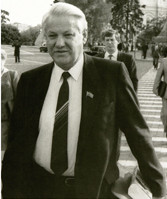
Birthday anniversary of Boris Nikolayevich Yeltsin, the first Russian president
February 1, 1931 in the village of Butka, Talitsky region, Sverdlovsk Oblast in a peasant family was born Boris Nikolayevich Yeltsin, Russian statesman, President of the Supreme Soviet of the RSFSR (1990-1991), first president of the Russian Federation (1991-1999), leader of the democratic movement of the late 1980s - early 1990s.
Having graduated from high school, Yeltsin entered the Civil Engineering Department of the S. M. Kirov Ural Polytechnic Institute of Sverdlovsk (now Yekaterinburg). From 1955 he worked in the construction industry, having risen from the master of a construction trust to the director of the Sverdlovsk house-building plant. In 1961, Yeltsin joined the Communist Party of the Soviet Union (KPSS). Seven years later he was appointed head of the department of construction of the Sverdlovsk regional party committee, then was elected Secretary (1975-1976) and the First Secretary (1976-1985) of the regional committee. He had worked briefly as the head of the department of construction of the Central Committee, then was elected Secretary of the KPSS Central Committee (1985). In December 1985, Yeltsin became First Secretary of the Moscow city committee of the Communist Party and a candidate member of Politburo of the Party Central Committee (1986-1988).
In 1987-1989 Yeltsin worked as first deputy chairman of USSR State Committee for Construction. At the first free elections in March 1989 he became a people’s deputy of the USSR.
In 1990, Yeltsin won the mandate of People's Deputies and, despite resistance from the party apparatus, was elected chairman of the Supreme Soviet of the RSFSR. June 12, 1990 on his initiative the Congress of People's Deputies adopted the Declaration on State Sovereignty of the RSFSR. Following a March 1991 referendum, during which two questions were considered - the preservation of the USSR as a renewed federation of equal and sovereign republics and the establishment of the post of President of Russia - Yeltsin was elected president of the RSFSR.
In August 1991, Yeltsin led the resistance to the State Committee of the State of Emergency and made the "Appeal to the Citizens of Russia". 6 November 1991 under the presidential decree, was closed the Communist Party and the Communist Party of the RSFSR on the territory of Russia. In early December 1991 in the Belovezhskaya Pushcha in Belarus, Yeltsin, along with the leaders of Belarus and Ukraine, signed the Accords on dissolving of the Soviet Union and the establishment of the Commonwealth of Independent States (CIS). December 25, 1991 RSFSR was given a new name - the Russian Federation. By this time, the president of Russia had formed a new government.
One of the main areas of Yeltsin’s work at the presidential post was the preparation and adoption of the current Constitution of the Russian Federation. At the I Congress of People's Deputies June 16, 1990 was established the Constitutional Commission, chaired by the President. Four months later, the draft constitution was prepared and issued for public discussion. V Congress of People's Deputies (September 1991), having considered the project, decided it needed to be revised. However, the increasing contradictions between the legislative and executive powers had caused difficulties with the adoption of the final draft of the Constitution. Approved by the Supreme Council the draft was published in May 1993.
In order to resolve the contradictions that had arisen on the draft constitution, May 12, 1993 Yeltsin issued a decree "On measures for the finalization of the new Russian Constitution, under which the Constitutional Assembly was to be convened in order to complete the drafting of the Constitution. The projects proposed by the Constitutional Commission and the President were submitted for discussion at the Assembly. Speaking at the plenary session of 26 June 1993, Yeltsin said: "As a result of hard work of both the Assembly participants and the Working Committee, we now have a single draft of the Constitution of Russia ...The version that we have today largely differs from the one which was originally proposed by the President, and from the project of the Constitutional Commission. This is a result of their creative revision, it is the synthesis, not a mechanical summary of diverse provisions and wordings. It has included the best of both projects". 12 July 1993 the project of the Constitution was approved by the Assembly. December 12, 1993 Russian Constitution was adopted by the national vote. Adoption of the Constitution and the State Duma elections on December 12, 1993 contributed to a constructive interaction between different branches of power.
The presidential elections of 1996 took place in a complex political and socio-economic environment. July 3, 1996, Yeltsin was re-elected head of state.
December 31, 1999 Yeltsin signed a decree on his resignation. V. V. Putin has become the acting Russian President.
April 23, 2007 Boris Yeltsin passed away.
April 23, 2008 on the anniversary of the death of Boris Yeltsin in Moscow on his grave at Novodevichy Cemetery was inaugurated a monument in the form of a flying Russian tricolor.
Lit.: Станских С. Н. Кому не выгодна история создания российской Конституции? // Конституционное и муниципальное право. 2007. № 5; Румянцев О. Г. Из истории создания Конституции РФ. Состязательный конституционный процесс. Два проекта Конституции (май – август 1993 г.) // Конституционное и муниципальное право. 2008. № 23-24; История создания Российской Конституции // Право и защита. 2008. № 12.
Based on the Presidential Library’s materials:
Yeltsin Boris Nikolayevich (1931-2007) // State Authority: [digital collection];
Constitution of the Russian Federation. 1993: [digital collection];
All-Union referendum on the preservation of the USSR, March 17, 1991: [fragments of newsreels];

